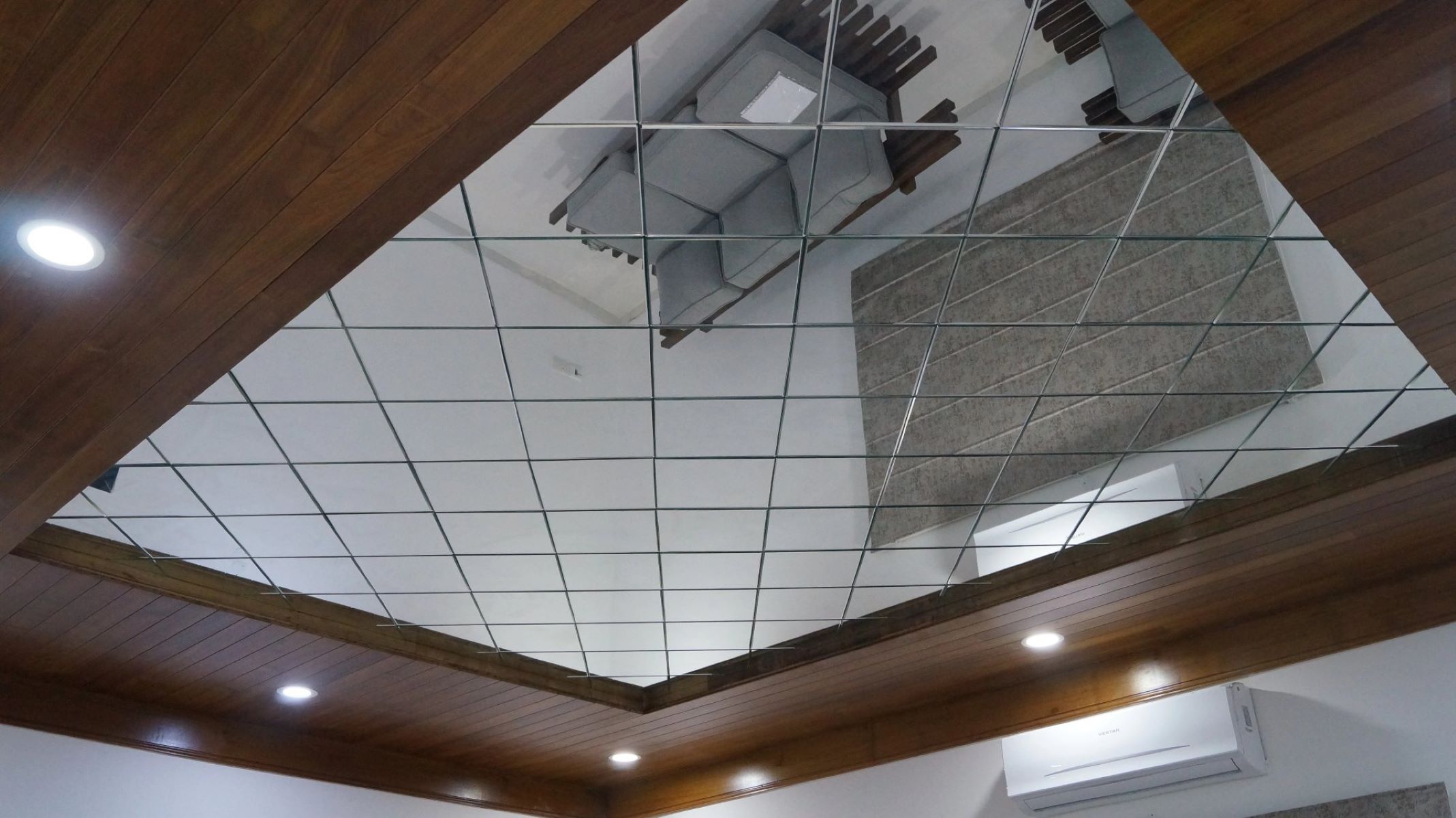Home>Furniture & Design>Interior Design Trends>How Do Glass Walls Differ From Glass Ceilings


Interior Design Trends
How Do Glass Walls Differ From Glass Ceilings
Modified: March 26, 2024
Discover the latest interior design trends and learn how glass walls and glass ceilings differ. Explore innovative ideas for your space.
(Many of the links in this article redirect to a specific reviewed product. Your purchase of these products through affiliate links helps to generate commission for Storables.com, at no extra cost. Learn more)
Introduction
In the realm of workplace dynamics and societal structures, the concepts of glass walls and glass ceilings have garnered significant attention in recent years. These metaphors are used to elucidate the barriers and obstacles that individuals encounter in professional and social settings, particularly in relation to gender, race, and other forms of diversity. Understanding the nuances of glass walls and glass ceilings is crucial for fostering inclusive environments and promoting equity and diversity.
The following sections will delve into the definitions of glass walls and glass ceilings, elucidate the factors that differentiate the two, explore their respective impacts, and provide strategies to overcome these barriers. By shedding light on these concepts, we can cultivate a deeper understanding of the challenges that many individuals face and work towards creating environments where talent and potential can flourish unhindered.
Key Takeaways:
- Glass walls hinder lateral career movement, while glass ceilings block upward progression. Both perpetuate inequality and underrepresentation, but can be overcome with equity-centric policies and inclusive leadership.
- Understanding and addressing glass walls and glass ceilings is crucial for fostering inclusive environments where talent can thrive. Organizations can dismantle these barriers with targeted strategies and create cultures of diversity and equal opportunity.
Read more: How Is Crystal Different From Glass
Definition of Glass Walls
Glass walls refer to the invisible barriers that hinder the lateral movement and advancement of individuals within an organization. Unlike the more widely recognized concept of glass ceilings, which obstruct upward career progression, glass walls impede individuals from transitioning laterally into different departments, roles, or projects. These barriers are often rooted in implicit biases, limited networking opportunities, and unequal access to resources and mentorship.
In essence, glass walls manifest as subtle yet formidable obstacles that impede individuals from exploring new avenues within their professional sphere. They can be attributed to various factors, including ingrained stereotypes, limited visibility of opportunities, and the prevalence of informal networks that inadvertently exclude certain individuals or groups.
One of the defining characteristics of glass walls is their elusive nature. Unlike tangible barriers, such as explicit policies or overt discrimination, glass walls operate beneath the surface, making them challenging to identify and address. Their insidious presence can perpetuate a sense of stagnation and thwart the potential for personal and professional growth.
Moreover, glass walls often intersect with other forms of systemic inequality, such as gender bias, racial discrimination, and socio-economic disparities. These intersections compound the challenges faced by individuals, further restricting their ability to navigate across different domains within their professional environment.
Recognizing the existence of glass walls is pivotal in fostering inclusive workplaces and dismantling systemic barriers. By acknowledging and addressing these invisible impediments, organizations can create pathways for individuals to explore diverse opportunities, leverage their skills, and contribute meaningfully to the collective success of the organization.
In summary, glass walls represent the subtle yet pervasive barriers that hinder lateral mobility and exploration within professional settings. Understanding and dismantling these barriers is essential for cultivating inclusive environments where individuals can navigate their career paths with equity and transparency.
Definition of Glass Ceilings
Glass ceilings symbolize the intangible yet formidable barriers that impede the vertical progression of individuals within organizations, particularly in the context of career advancement and leadership roles. These barriers are often rooted in systemic biases, discriminatory practices, and entrenched stereotypes that hinder the upward mobility of individuals, especially those belonging to underrepresented groups.
At its core, the concept of glass ceilings embodies the pervasive yet often subtle obstacles that prevent individuals from ascending to upper echelons of leadership and influence within their professional spheres. These barriers are not confined to explicit policies or overt acts of discrimination; rather, they manifest as deeply ingrained societal and organizational norms that limit the career trajectories of individuals based on factors such as gender, race, ethnicity, and other forms of diversity.
The metaphor of a glass ceiling evokes the notion of an invisible yet impenetrable barrier that obstructs the upward progression of talented and capable individuals. This barrier is transparent, allowing individuals to see the opportunities and positions that lie beyond it, yet it remains unyielding, preventing them from reaching their full potential. As a result, individuals encounter limitations in accessing senior leadership roles, executive positions, and board memberships, thereby perpetuating a lack of diversity and representation at the uppermost levels of organizations.
Moreover, glass ceilings intersect with broader societal and systemic inequalities, compounding the challenges faced by individuals from marginalized groups. The intersectionality of these barriers further exacerbates the disparities in career advancement and perpetuates the underrepresentation of diverse voices in positions of influence and decision-making.
Recognizing and addressing the existence of glass ceilings is paramount in fostering inclusive and equitable environments within organizations. By dismantling these barriers, organizations can create pathways for individuals to ascend to leadership roles based on merit, competence, and potential, rather than being hindered by systemic biases and discriminatory practices.
In essence, understanding the concept of glass ceilings is pivotal in fostering environments where individuals can ascend to the highest levels of leadership, contribute their unique perspectives, and drive meaningful change within their organizations. By dismantling these invisible barriers, organizations can cultivate a culture of inclusivity, diversity, and equal opportunity, thereby unlocking the full potential of their talent pool.
Factors that Differentiate Glass Walls from Glass Ceilings
The differentiation between glass walls and glass ceilings lies in the nature of the barriers they present within professional and organizational contexts. While both concepts encompass invisible obstacles that hinder individuals' progress, they manifest in distinct ways and impact different aspects of career advancement and mobility.
Nature of Obstacles
Glass walls primarily impede lateral movement and exploration within an organization. They create barriers that hinder individuals from transitioning into different departments, roles, or projects, limiting their ability to explore diverse opportunities and expand their skill sets. In contrast, glass ceilings obstruct upward career progression, particularly in accessing senior leadership roles, executive positions, and board memberships. The nature of the obstacles posed by glass walls and glass ceilings is inherently different, with the former restricting lateral mobility and the latter impeding vertical advancement.
Visibility and Transparency
Another differentiating factor is the visibility and transparency of these barriers. Glass walls, akin to their namesake, are often transparent and elusive, making them challenging to identify. These barriers operate beneath the surface, hindering individuals' lateral exploration without being overtly conspicuous. On the other hand, glass ceilings, while also transparent, symbolize a more visible and widely acknowledged phenomenon. The limitations they impose on individuals' upward progression are often recognized and discussed within the context of diversity and inclusion initiatives, making them more apparent in organizational discourse.
Impact on Career Trajectory
The impact of glass walls and glass ceilings on individuals' career trajectories also sets them apart. Glass walls restrict individuals from exploring lateral opportunities, limiting their ability to diversify their experiences and skill sets within the organization. This can lead to a sense of stagnation and hinder their professional growth. In contrast, glass ceilings impede individuals' access to senior leadership and executive positions, curtailing their ability to ascend to the highest levels of influence and decision-making within the organization. The impact of these barriers extends beyond individual career trajectories, influencing the overall diversity and representation at different levels of the organizational hierarchy.
Intersectionality and Systemic Bias
Moreover, the differentiation between glass walls and glass ceilings is influenced by their intersectionality and the systemic biases they encompass. Glass walls often intersect with factors such as gender bias, racial discrimination, and socio-economic disparities, compounding the challenges faced by individuals from diverse backgrounds. Conversely, glass ceilings intersect with broader societal and systemic inequalities, perpetuating the underrepresentation of diverse voices in leadership roles and reinforcing existing power dynamics within organizations.
In essence, the differentiation between glass walls and glass ceilings lies in the nature of the obstacles they present, their visibility and transparency, their impact on career trajectories, and their intersectionality with systemic biases. Understanding these distinctions is crucial for devising targeted strategies to overcome these barriers and fostering inclusive environments where individuals can navigate their career paths with equity and transparency.
Impact of Glass Walls and Glass Ceilings
The impact of glass walls and glass ceilings reverberates across organizational dynamics, individual career trajectories, and the broader landscape of diversity and inclusion. These invisible yet formidable barriers wield profound influence, shaping the experiences of individuals within professional settings and contributing to systemic disparities in career advancement and representation.
Read more: What Makes Ceiling Paint Different
Stifling Potential and Growth
Glass walls, by impeding lateral mobility and exploration, stifle the potential for individuals to diversify their experiences and skill sets within an organization. This limitation can lead to a sense of stagnation and thwart the natural progression of talent across different departments and roles. As a result, individuals may find themselves confined to a narrow scope of opportunities, hindering their professional growth and capacity to contribute meaningfully to the organization.
Similarly, glass ceilings, by obstructing upward career progression, curtail the advancement of capable individuals to senior leadership and executive positions. This limitation not only hampers the personal growth and aspirations of individuals but also deprives organizations of diverse perspectives and innovative leadership. The impact of glass ceilings extends beyond individual aspirations, influencing the overall composition of leadership teams and the representation of diverse voices in decision-making processes.
Perpetuating Inequality and Underrepresentation
The presence of glass walls and glass ceilings perpetuates systemic inequalities and underrepresentation within organizations. Individuals from underrepresented groups often encounter compounded barriers, stemming from the intersectionality of these obstacles with factors such as gender bias, racial discrimination, and socio-economic disparities. This perpetuation of inequality not only hampers the career progression of individuals but also undermines the principles of equity and meritocracy within organizational structures.
Moreover, the underrepresentation of diverse voices at different levels of the organizational hierarchy, exacerbated by glass ceilings, hinders the creation of inclusive environments and limits the potential for organizational innovation and adaptability. The absence of diverse perspectives in leadership roles diminishes the capacity of organizations to address complex challenges, respond to evolving market dynamics, and foster a culture of creativity and inclusivity.
Cultivating Inclusive Environments
Understanding the impact of glass walls and glass ceilings is pivotal in cultivating inclusive environments where talent can flourish unhindered. By recognizing and addressing these barriers, organizations can create pathways for individuals to explore diverse opportunities, ascend to leadership roles based on merit, and contribute their unique perspectives to the collective success of the organization.
In essence, the impact of glass walls and glass ceilings extends beyond individual career trajectories, permeating the fabric of organizational culture and diversity. By dismantling these barriers, organizations can foster environments where individuals are empowered to navigate their career paths with equity and transparency, thereby unlocking the full potential of their talent pool and driving sustainable success.
Strategies to Overcome Glass Walls and Glass Ceilings
Addressing and dismantling glass walls and glass ceilings necessitates a multifaceted approach that encompasses organizational policies, cultural shifts, and individual empowerment. By implementing targeted strategies, organizations can proactively mitigate these barriers and foster inclusive environments where talent and potential can thrive unhindered.
1. Equity-Centric Policies and Practices
Organizations can institute equity-centric policies and practices aimed at mitigating the impact of glass walls and glass ceilings. This includes implementing transparent and unbiased promotion and hiring processes, conducting regular pay equity audits, and establishing mentorship and sponsorship programs to provide support and guidance for individuals from underrepresented groups.
2. Diversity and Inclusion Training
Comprehensive diversity and inclusion training can raise awareness about the existence and impact of glass walls and glass ceilings. By educating employees and leaders about implicit biases, systemic barriers, and the importance of fostering inclusive environments, organizations can cultivate a culture of awareness and accountability, thereby mitigating the perpetuation of these barriers.
3. Mentorship and Sponsorship Programs
Establishing mentorship and sponsorship programs can provide individuals with access to guidance, support, and advocacy within the organization. These programs can specifically target individuals who may encounter glass walls and glass ceilings, offering them opportunities for skill development, networking, and career advancement support.
4. Transparent Career Development Pathways
Organizations can create transparent career development pathways that facilitate lateral mobility and upward progression based on merit and potential. By providing clear visibility into opportunities for growth, organizations can mitigate the impact of glass walls and glass ceilings, enabling individuals to explore diverse career trajectories within the organization.
Read more: What Do You Paint First: Ceiling Or Walls?
5. Data-Driven Accountability
Utilizing data-driven metrics and accountability measures can help organizations track and address disparities related to glass walls and glass ceilings. By analyzing promotion rates, representation in leadership roles, and employee feedback, organizations can identify areas for improvement and implement targeted interventions to mitigate the impact of these barriers.
6. Cultivating Inclusive Leadership
Fostering inclusive leadership that values diverse perspectives and actively advocates for equity and representation is pivotal in overcoming glass walls and glass ceilings. Organizations can prioritize the development of inclusive leadership competencies, emphasizing the importance of creating environments where individuals from all backgrounds can thrive and contribute meaningfully.
7. Intersectional Approaches
Recognizing the intersectionality of glass walls and glass ceilings is crucial in devising targeted strategies. Organizations can adopt intersectional approaches that address the compounded barriers faced by individuals from diverse backgrounds, ensuring that strategies to overcome these barriers are inclusive and equitable across all dimensions of diversity.
By implementing these strategies, organizations can proactively dismantle glass walls and glass ceilings, creating environments where individuals can navigate their career paths with equity and transparency. These efforts not only mitigate the impact of these barriers but also foster cultures of inclusivity, diversity, and equal opportunity, thereby unlocking the full potential of their talent pool and driving sustainable success.
Conclusion
In conclusion, the concepts of glass walls and glass ceilings encapsulate the pervasive yet often invisible barriers that hinder individuals' career mobility and progression within organizations. The differentiation between glass walls and glass ceilings lies in the nature of the obstacles they present, their impact on career trajectories, and their intersectionality with systemic biases. While glass walls impede lateral movement and exploration, glass ceilings obstruct upward career progression, perpetuating systemic inequalities and underrepresentation within organizations.
The impact of glass walls and glass ceilings reverberates across organizational dynamics, individual career trajectories, and the broader landscape of diversity and inclusion. These barriers stifle the potential for individuals to diversify their experiences, curtail the advancement of capable individuals to senior leadership and executive positions, and perpetuate systemic inequalities and underrepresentation within organizations. Recognizing and addressing the existence of these barriers is pivotal in cultivating inclusive environments where talent can flourish unhindered.
To overcome glass walls and glass ceilings, organizations can implement equity-centric policies and practices, provide comprehensive diversity and inclusion training, establish mentorship and sponsorship programs, create transparent career development pathways, utilize data-driven accountability measures, foster inclusive leadership, and adopt intersectional approaches. By implementing these strategies, organizations can proactively dismantle these barriers, fostering cultures of inclusivity, diversity, and equal opportunity.
In essence, understanding and addressing glass walls and glass ceilings is essential for fostering inclusive environments where individuals can navigate their career paths with equity and transparency. By dismantling these barriers, organizations can unlock the full potential of their talent pool, drive sustainable success, and contribute to the advancement of diversity, equity, and inclusion in the professional landscape.
Frequently Asked Questions about How Do Glass Walls Differ From Glass Ceilings
Was this page helpful?
At Storables.com, we guarantee accurate and reliable information. Our content, validated by Expert Board Contributors, is crafted following stringent Editorial Policies. We're committed to providing you with well-researched, expert-backed insights for all your informational needs.












0 thoughts on “How Do Glass Walls Differ From Glass Ceilings”